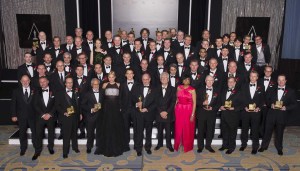
Increasingly, though, as the technology involved in image-capture expands – since fewer and fewer movies are made using film anymore – the Academy has found itself with more tools, and more creators, to honor. And as this technology becomes ubiquitous in other fields besides filmmaking, it turns out that a lot of those honorees have left the film biz altogether. If you invent an aperture specific to film cameras, or a new kind of dolly track, you’ll need to stay close to Hollywood for that particular ingenuity to be used. On a night where “multiple voxels” were getting a shout-out, you might wind up working instead in video games, or for corporations looking into 3-D imagery to sell their products, or perhaps doing black box research for Google.
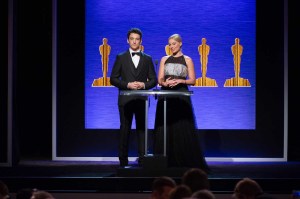
Along with folks being honored for the MOVA Facial Performance Capture System (an award not without its controversy, as The Hollywood Reporter recently ran a letter from the President and CEO of Reardon MOVA, saying the selection of honorees was incorrect, in terms of who should get full credit for developing the technology), it was the Academy’s night to recognize how “character makeup” has changed the face of movies, going back to The Matrix trilogy, the Oscar-winning FX work in The Curious Case of Benjamin Button, and more.
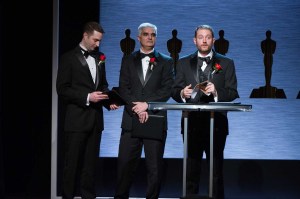
A more intimate kind of foliage was recognized in the honoring of Weta Digital’s Barbershop hair grooming system, used to outlandishly coiffe dwarves and many other creatures whose virtual wigs become indistinguishable from the real thing.
Aside from a certain recurring theme in recognizing work that alters or enhances how people look, “destruction” was another motif for the evening.
The Kali Destruction System, named for the Hindu goddess with a penchant to destroy, was, doubtless the evening’s best-named software system. Along with DMM – the Digital Molecular Matter toolkit – Kali was recognized for “realistic fracture and deformation simulations” which another of the night’s honorees, ILM’s PhysBAM system, also excelled at. You can’t, after all, have a successful franchise of movie tentpoles – whether set in space, or Justice League or Avenger Headquarters – unless stuff can blow up and implode convincingly.
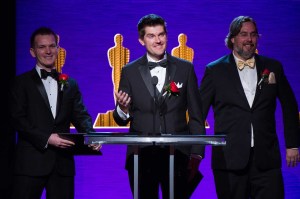
While the implements of movie-making continue to change rapidly, the creators of those implements all seemed quite familiar – which is to say, male and white. This was discussed among all the white males at our own table, along with their female guests, and it was then vigorously pointed out that the four Japanese creators of Sony’s BVM-E Series OLED Master Monitor – allowing “creative decisions to be made on set with confidence” – represented, almost, the breadth of the evening’s diversity.
Almost.
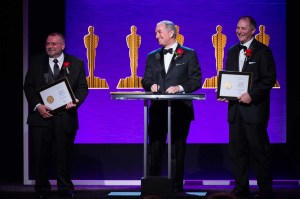
In this instance, this may or may not speak to the current conversation about diversity at Oscar time. After all, the Academy can’t help who invents the stuff that everyone in Tinsel Town starts using or rendering with. But it may well speak to the kinds of careers “girls” are encouraged to – or discouraged from – pursuing.
Meanwhile, back at our table, the reunion of the Universal Capture folks continued. They had other colleagues seated there, who’d helped craft the system, but weren’t the officially designated honorees. Only two of the group, Borshukov said, were still in film. He mentioned a couple of well-known retail brands he was working with, as they pursued some 3D-style marketing of their own.
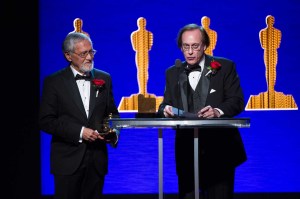
Eventually, we were able to establish that neither teleportation, nor time travel, were current active projects there, even though there was some thought that each would need to be invented eventually.
What those inventions will do to entertainment, one can only imagine. As for the spacetime we’re left to deal with on this dimensional plane, however, hosts Margot Robbie and Miles Teller kept things moving along, or at least – given the stops and starts for dinner and dessert – allowed themselves to make increasingly welcome divergences from the teleprompter as the evening wore on.
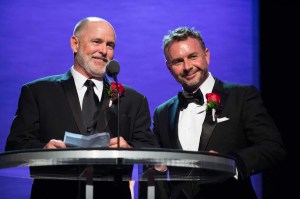
And what is a voxel? It’s like a 3D pixel – combination of “volume” and “pixel.” Expect more of them in the movies you’ll be seeing. And expect the Academy to grapple with eventually finding a bigger space than its comfortable Beverly Wilshire digs, simply because of the expanding number of software R&D teams they’ll be honoring.
Google X may not have invented time travel yet, but the future keeps steadily arriving, nonetheless.
The honorees for scientific and technical achievements are:
Technical Achievement Awards (Academy Certificates)
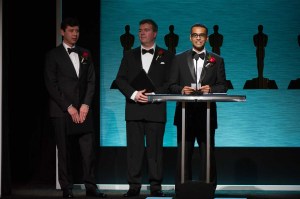
Peter Braun for the concept and development of the MAT-Towercam Twin Peek, a portable, remote-controlled, telescoping column that smoothly positions a camera up to 24 feet vertically. This small cross-section system from Mad About Technology can operate from above or below the camera, achieving nearly impossible shots with repeatable movements through openings no larger than the camera itself.
Robert Nagle and Allan Padelford for The Biscuit Jr. self-propelled, high-performance, drivable camera and vehicle platform. The Biscuit Jr.’s unique chassis and portable driver pod enables traveling photography from a greater range of camera positions than previously possible, while keeping actors safe and the rig out of frame.
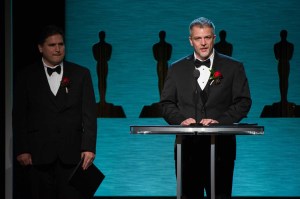
Cary Phillips, Nico Popravka, Philip Peterson and Colette Mullenhoff for the architecture, development and creation of the artist-driven interface of the ILM Shape Sculpting System. This comprehensive system allows artists to quickly enhance and modify character animation and simulation performances. It has become a crucial part of ILM’s production workflow over the past decade.
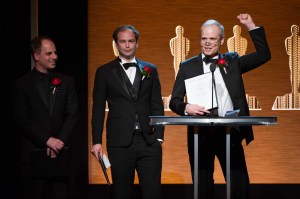
Dan Piponi, Kim Libreri and George Borshukov for their work in the development of Universal Capture at ESC Entertainment. The Universal Capture system broke new ground in the creation of realistic human facial animation. This technology produced an animated, high-resolution, textured mesh driven by an actor’s performance.
Marco Revelant for the original concepts and artistic vision, and to Alasdair Coull and Shane Cooper for the original architectural and engineering design, of the Barbershop hair grooming system at Weta Digital. Barbershop’s unique architecture allows direct manipulation of full-density hair using an intuitive, interactive and procedural toolset, resulting in greatly enhanced productivity with finer-grained artistic control than is possible with other existing systems.
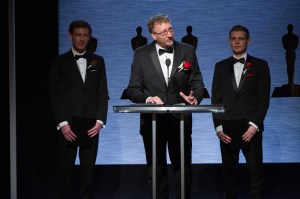
Scott Peterson, Jeff Budsberg and Jonathan Gibbs for the design and implementation of the DreamWorks Animation Foliage System. This toolset has a hierarchical spline system, a core data format and an artist-driven modeling tool, which have been instrumental in creating art-directed vegetation in animated films for nearly two decades.
Erwin Coumans for the development of the Bullet physics library, and to Nafees Bin Zafar and Stephen Marshall for the separate development of two large-scale destruction simulation systems based on Bullet. These systems demonstrated that large numbers of constrained rigid bodies could be used to animate visually complex, believable destruction effects with minimal simulation time.
Brice Criswell and Ron Fedkiw for the development of the ILM PhysBAM Destruction System. This system incorporates innovative research on many algorithms that provide accurate methods for resolving contact, collision and stacking into a mature, robust and extensible production toolset. The PhysBAM Destruction System was one of the earliest toolsets capable of depicting large-scale destruction with a high degree of design control.
Ben Cole for the design of the Kali Destruction System, to Eric Parker for the development of the Digital Molecular Matter toolkit, and to James O’Brien for his influential research on the finite element methods that served as a foundation for these tools. The combined innovations in Kali and DMM provide artists with an intuitive, art-directable system for the creation of scalable and realistic fracture and deformation simulations. These tools established finite element methods as a new reference point for believable on-screen destruction.
Magnus Wrenninge for leading the design and development of Field3D. Field3D provides a flexible and open framework for storing and accessing voxel data efficiently. This allows interchange between previously incompatible modeling, simulation and rendering software.
Robert Bridson for early conceptualization of sparse-tiled voxel data structures and their application to modeling and simulation. Robert Bridson’s pioneering work on voxel data structures and its subsequent validation in fluid simulation tools have had a significant impact on the design of volumetric tools throughout the visual effects industry.
Ken Museth, Peter Cucka and Mihai Alden for the creation of OpenVDB. OpenVDB is a widely adopted, sparse hierarchical data structure that provides a fast and efficient mechanism for storing and manipulating voxels.
Scientific And Engineering Awards (Academy Plaques)
lain Neil for the optical design, and to Andre de Winter for the mechanical design, of the Leica Summilux-C series of lenses. Incorporating novel telecentric multi-element aspherical optics, these camera lenses have delivered unprecedented optical and mechanical performance.
Brad Walker, D. Scott Dewald, Bill Werner, Greg Pettitt and Frank Poradish for their contributions furthering the design and refinement of the Texas Instruments DLP Cinema projection technology, whose high level of performance enabled color-accurate digital intermediate preview and motion picture theatrical presentation. Working in conjunction with the film industry, Texas Instruments created a high-resolution, high-quality digital projection system that has replaced most film-based projection systems in the theatrical environment.
Ichiro Tsutsui, Masahiro Take, Mitsuyasu Tamura and Mitsuru Asano for the development of the Sony BVM-E Series Professional OLED Master Monitor. These precise, wide-gamut monitors allow creative image decisions to be made on set with confidence that the desired images can be accurately reproduced in postproduction.
John Frederick, Bob Myers, Karl Rasche and Tom Lianza for the development of the HP DreamColor LP2480zx Professional Display. This cost-effective display offered a stable, wide color gamut, allowing facility-wide adoption in feature animation and visual effects studios.
Academy Award of Commendation (Special Plaque)
Steven Tiffen, Jeff Cohen and Michael Fecik for their pioneering work in developing dye-based filters that reduce IR contamination when neutral density filters are used with digital cameras. The Tiffen Company identified the problem and rapidly engineered a series of absorptive filters that ameliorated infrared artifacts with lenses of all focal lengths. These widely adopted filters allow cinematographers to work as they have done with film-based technology.
Academy Award of Merit (Oscar Statuette)
Dr. Larry Hornbeck for the invention of digital micromirror technology as used in DLP Cinema projection. The Digital Micromirror Device (DMD) is the core technology that has enabled Texas Instruments’ DLP Cinema projection to become the standard of the motion picture industry.
Gordon E. Sawyer Award (Oscar Statuette)
David Gray – given to an individual in the motion picture industry whose technological contributions have brought credit to the industry.





